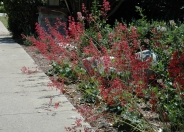
Common name: South Western Coral Bells
Botanical name: Heuchera sanguinea
Tufts of round leaves 2"-3" wide with scalloped edges accent this plant. It also produces wiry stems to 24" tall with open clusters of tiny, reddish pink, bell-shaped, fragrant flowers. Native to Desert Southwest so it tolerates desert heat, not humidity of deep South. It can also be grown in Colorado and Oregon in full sun with cool temperatures. This Heuchera typically spreads 12". Flowers can be used for vases. Prune spent flowers to encourage more blooming. This perennial has a mounding habit. In warmer and hot areas, plant in shade or part shade. This plant does best with well draining, fertile, moist soil. It does not tolerate clay soil well but will perform in rocky soil. Looks great in containers or along walkways.
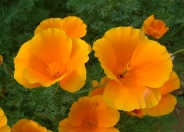
Common name: California Poppy
Botanical name: Eschscholzia californica
The California State Flower. This small annual (sometimes acts as a perennial) plant will grow to less than 1' tall and has light, small blue green leaves with gold and orange flowers that bloom in spring and summer. It is an aggressive grower and can get away from you in a residential garden space. Plant it in spaces where it is alright for it to roam.
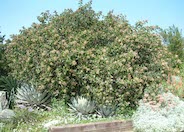
Common name: Sugar Bush
Botanical name: Rhus ovata
Sugar Bush is a dense, rounded evergreen shrub growing 8'-15' tall and wide with creamy flowers in spring. Small red fruit follows blooms, which are edible. It grows well in inland areas and is drought tolerant. Leathery, rich, dark foliage is evergreen. It prefers full sun and well draining soil. It is drought tolerant once it's established although it could use additional irrigation in hot summer areas. Do not plant in wet areas.
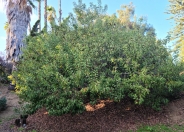
Common name: Laurel Sumac
Botanical name: Malosma laurina
Laurel Sumac Malosma laurina one of the predominant evergreen shrubs populating the hillsides of coastal Southern California. It grows quickly and strong, forming a rounded shape, but may die back from a cold frost. Leaves on this plant are up to 6 inches long, leathery, folded and curved back which starting out red then turning to a bright green. Frequently the red color remains in the mature leaf's edges. Stems also start out red, then turn reddish-brown then sometimes gray as the plant matures. Flowering occurs in early summer primarily, with the terminal clusters of small cream-colored flowers quickly giving way to red berries with white seeds. The flower clusters persist on the plant well after the flowers and berries are spent.
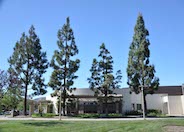
Common name: Canary Island Pine
Botanical name: Pinus canariensis
This graceful, slender-growing pine has a pyramidal form to about 70'. Its needles are long and drooping in bundles of 3. The foliage is a blue-green color, maturing to a dark green shade. Needles can grow to 12" long. Flowers are insignificant. Cones appear in the spring.